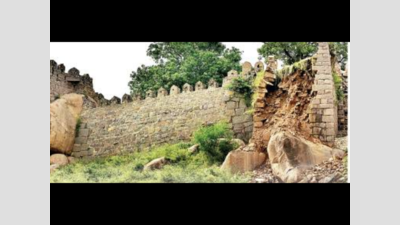- News
- City News
- Hyderabad News
- Hyderabad: Centre ignores ASI warning on Golconda Fort
Trending
This story is from October 23, 2020
Hyderabad: Centre ignores ASI warning on Golconda Fort
The Qutub Shahi quake-proof architecture may have kept the Golconda Fort unrattled for five centuries, but official negligence is now taking a heavy toll on this magnificent monument of great historical importance. The fortification around the fort breached at least at three places last week, as decades of neglect made the stone-mud wall too feeble to withstand the onslaught of heavy rains.

Golconda Fort
HYDERABAD: The Qutub Shahi quake-proof architecture may have kept the Golconda Fort unrattled for five centuries, but official negligence is now taking a heavy toll on this magnificent monument of great historical importance. The fortification around the fort breached at least at three places last week, as decades of neglect made the stone-mud wall too feeble to withstand the onslaught of heavy rains.
According to sources, long before the rains brought down portions of the fortification of the Fort, the Hyderabad circle of Archaeological Survey of India (ASI) sent a report to its headquarters pinpointing the cracks developed on the fort wall and seeking funds for repairs.Sources said only 15% of its original budgetary allocation is earmarked for the Hyderabad ASI circle that controls South India’s biggest fort complex and world’s biggest necropolis.
But as the ASI headquarters sat on the report, the incessant rains, meanwhile, played havoc with the city’s major landmark that lent its name to three cities outside India. Two cities in the USA and one city in Trinidad and Tobago are named after Golconda. Ironically, a replica of Charminar, another Qutub Shahi structure, built in Bukhara city of Uzbekistan in 1807, has been awarded the world heritage tag, while the original structure in Hyderabad craves for the recognition, along with the Golconda Fort.
According to heritage experts, while there is no threat to the main fort and its buildings including the Bala Hisar (summit of the fort), jail, durbar hall, temple, mosque, baradari, Ambar khana, and the mahals, the fortification wall, ramparts, gates and bastions are under threat. While the main structures are located on a plain area where rainwater does not log, there is every danger of water seeping into the outer fortification, ramparts and bastions. The gap between stones has widened so much that rainwater started flowing through them with force.
“I inspected the fort... There are large cracks at various places. They need to be fixed immediately. The damaged portions can be restored. Unless the fort is strengthened the next episode of heavy rainfall may turn out to be the nemesis,” said INTACH Hyderabad convener, P Anuradha Reddy.
City historian Dr Mohammad Safiullah said Golconda Fort needs regular care and maintenance as it is a stone and mud structure.
According to sources, long before the rains brought down portions of the fortification of the Fort, the Hyderabad circle of Archaeological Survey of India (ASI) sent a report to its headquarters pinpointing the cracks developed on the fort wall and seeking funds for repairs.Sources said only 15% of its original budgetary allocation is earmarked for the Hyderabad ASI circle that controls South India’s biggest fort complex and world’s biggest necropolis.
But as the ASI headquarters sat on the report, the incessant rains, meanwhile, played havoc with the city’s major landmark that lent its name to three cities outside India. Two cities in the USA and one city in Trinidad and Tobago are named after Golconda. Ironically, a replica of Charminar, another Qutub Shahi structure, built in Bukhara city of Uzbekistan in 1807, has been awarded the world heritage tag, while the original structure in Hyderabad craves for the recognition, along with the Golconda Fort.
According to heritage experts, while there is no threat to the main fort and its buildings including the Bala Hisar (summit of the fort), jail, durbar hall, temple, mosque, baradari, Ambar khana, and the mahals, the fortification wall, ramparts, gates and bastions are under threat. While the main structures are located on a plain area where rainwater does not log, there is every danger of water seeping into the outer fortification, ramparts and bastions. The gap between stones has widened so much that rainwater started flowing through them with force.
Experts say the fort needs at least Rs50 crore for immediate upkeep. A close inspection reveals that while areas inside the fortification are relatively safe, those close to habitations are crumbling down. ASI is understaffed in Hyderabad to properly take care of the monuments.
“I inspected the fort... There are large cracks at various places. They need to be fixed immediately. The damaged portions can be restored. Unless the fort is strengthened the next episode of heavy rainfall may turn out to be the nemesis,” said INTACH Hyderabad convener, P Anuradha Reddy.
City historian Dr Mohammad Safiullah said Golconda Fort needs regular care and maintenance as it is a stone and mud structure.
End of Article
FOLLOW US ON SOCIAL MEDIA











